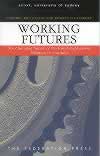Employment Relations in the Asia Pacific, edited by
Greg Bamber
This important new book analyses work and employment relations in seven countries: Australia; Indonesia; Japan; New Zealand; the People's Republic of China (PRC); South Korea; and Taiwan.
Professor Greg Bamber of Australia's Griffith University points out that by the year 2020 eight of the 12 largest economies in the world will be from the Asia Pacific region. This book reviews recent developments in that region: first, in three advanced market economies - Australia, New Zealand and Japan; second, in two of the dynamic 'tigers' - the newly industrialising economies South Korea and Taiwan; and third, from the next group of Asian industrialisers - Indonesia and the People's Republic of China.
He argues "This third group is in danger of being caught in a 'sandwich trap' of cheap labour competition from below and exclusion from higher value-added markets above. In earlier years, the 'tigers' faced the same trap."
"Some consumers in Britain and other industrialised countries may express concern that shoes and clothes are made by children or other forms of 'sweated labour' in say Indonesia or China. Yet these consumers know very little about working conditions in these countries."
The book also reviews development of the Asia Pacific Economic Cooperation (APEC) forum, which, Bamber observes, "may in the future be the scene of similar tensions about globalisation as seen at the recent 2001 Summit of the G8 countries' leaders in Genoa."
Australia and New Zealand Since 1993, legislation in Australia has encouraged employers and workers to negotiate individual or collective industrial agreements at the workplace. There is not much evidence that many employing organisations have adopted sophisticated Human Resource Management (HRM) policies. Nonetheless, there has been a significant and continuing decline in unionisation.
A significant factor in New Zealand's programme of employment relations reform was its Employment Contracts Act 1991, which abolished the arbitration system, and de-emphasised collective bargaining. The size and role of unions were severely curtailed so that most employers were no longer confronted by much countervailing power from unions. Something of a reversal has taken place with the return of a Labour-Alliance government in 1999 that has formulated legislation to encourage 'good faith' collective bargaining involving legally recognised unions.
Japan Japanese employment relations and personnel practices have long been of interest to observers from other countries, particularly during the 1980s when they helped to explain the superior competitive performance of Japanese products on world markets. Since the early 1990s, however, the Japanese economy has been sluggish and some stereotyped-Japanese phenomena like lifetime employment have come under pressure.
This is against the background of the adoption by Japanese firms of cost-cutting measures like downsizing and re-engineering that are given the credit for resuscitating competitiveness in American industry in the 1990s. In spite of such pressure, most core employees in blue-chip Japanese companies still enjoy a form of lifetime employment. Unlike many of their counterparts in western countries, such companies have been reluctant to lose their investment in human capital and have continued to invest in training and development. There have been remarkably few compulsory redundancies in blue-chip Japanese companies.
Japanese approaches to kaizen (continuous improvement) and employee involvement are especially important. The emphasis of kaizen on employee-driven problem solving is a strong counterpoint to the top-down notion of 're-engineering'. Most western managers seem to believe that employment security restrains managerial flexibility. However, Japanese managers tend to see employment security as essential to the flexibility associated with promoting kaizen and employee involvement.



